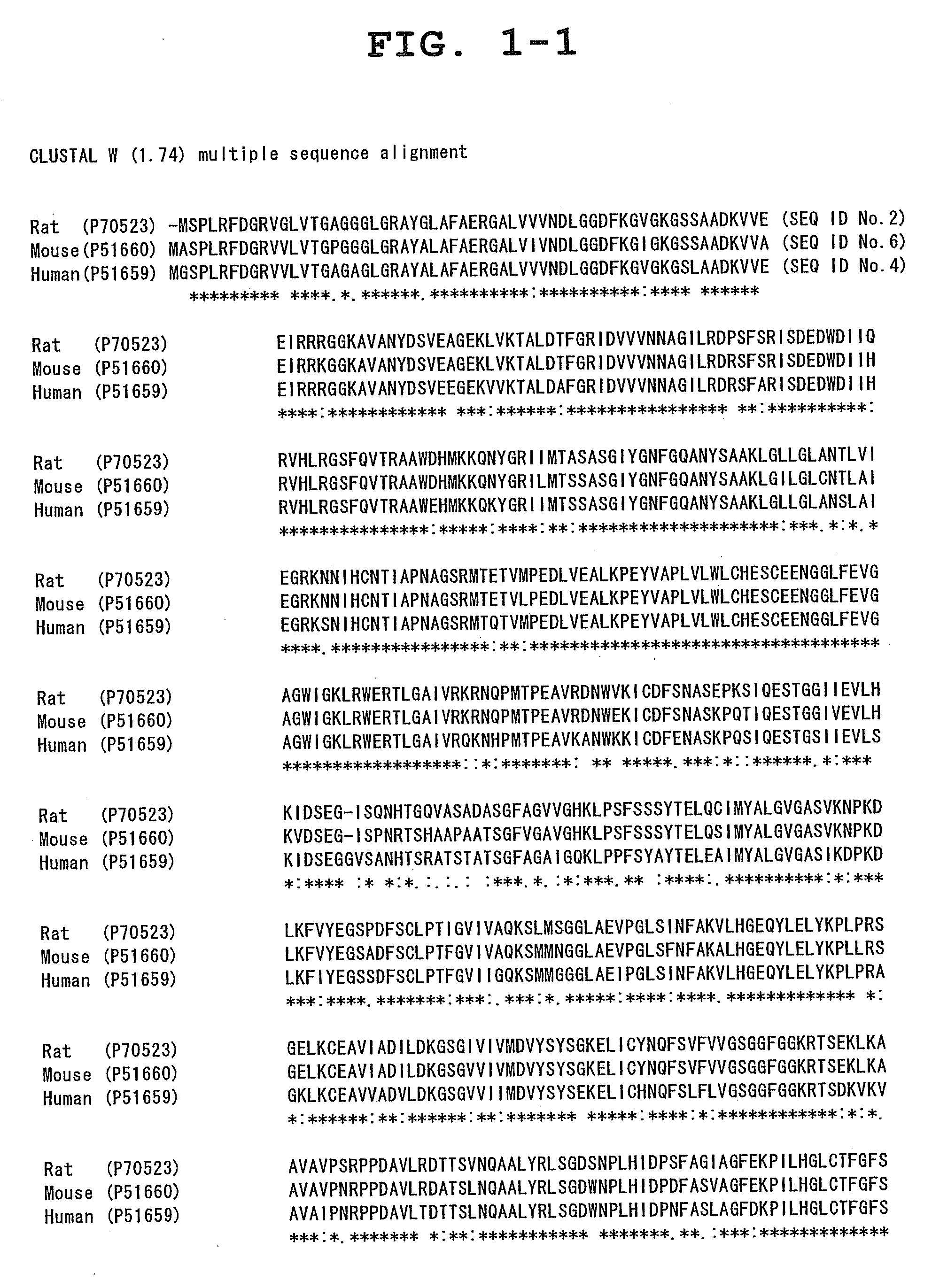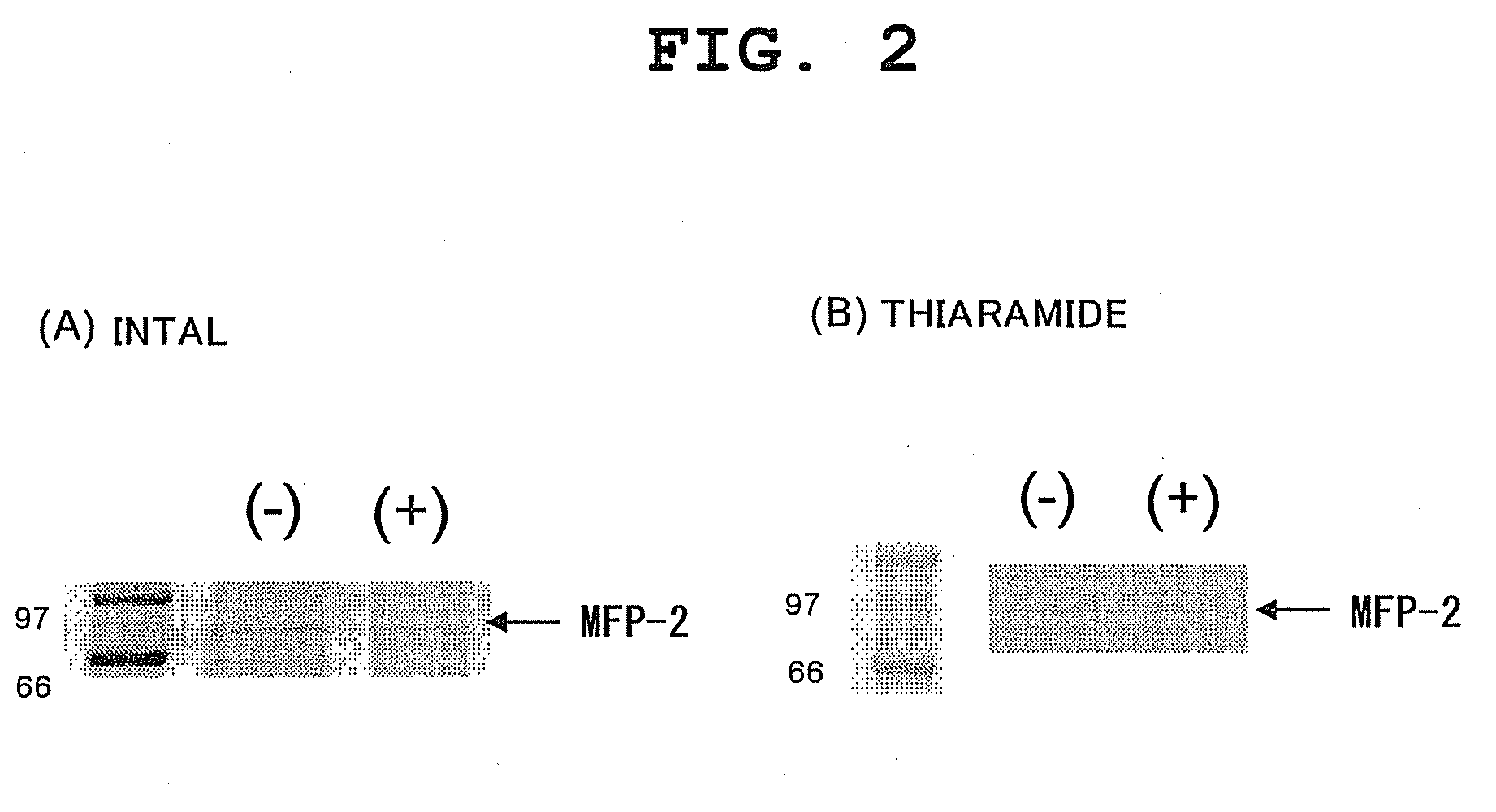Novel drug discovery target and medicine acting on the same
a drug discovery and target technology, applied in the field of new drug discovery targets, can solve the problems of unresolved problems such as the identification of targets with which these drugs interact directly, and the explanation of pharmacological activity, and it is extremely difficult to create a drug surpassing these compounds
- Summary
- Abstract
- Description
- Claims
- Application Information
AI Technical Summary
Problems solved by technology
Method used
Image
Examples
example 1
Synthesis of Intal-Immobilized Resin
(1) Synthesis of 1,3-bis(2-carboxychromon-5-yloxy)-2-hydroxypropane
[0080]
[0081]The disodium salt of 1,3-bis(2-carboxychromon-5-yloxy)-2-hydroxypropane (Intal; 1 g) was dissolved in 50 ml of water. Dilute hydrochloric acid was added to obtain a pH of 3. The precipitated white crystal was collected by filtration and washed with water, ethanol, and ether. The crystal was dried under reduced pressure to yield a white crystal of 1,3-bis(2-carboxychromon-5-yloxy)-2-hydroxypropane (600 mg, yield 66%). 1H-NMR (DMSO-d6) δ: 4.30 (4H, d), 4.36 (1H, t), 5.32 (1H, bs), 6.86 (2H, s), 7.11 (2H, d), 7.17 (2H, d), 7.71 (2H, t).
(2) Synthesis of 1,3-bis(2-carboxychromon-5-yloxy)-2-hydroxypropane-immobilized resin
[0082]
1) Immobilization of 1,3-bis(2-carboxychromon-5-yloxy)-2-hydroxypropane
[0083]To an acetonitrile suspension (0.5 ml) of 1,3-bis(2-carboxychromon-5-yloxy)-2-hydroxypropane (18.7 mg, 0.04 mmol), a toluene solution of phosgene (1.45 mol / 1,275 μl) was added...
example 2
Synthesis of Tiaramide-Immobilized Resin
(1) Synthesis of TOYO-Pearl Resin Conjugated with Tiaramide
[0085]
[0086]Tiaramide (36 mg, 0.1 mmol) was dissolved in 1 ml of dichloromethane, and the solution was stirred at room temperature. Succinic anhydride (12 mg, 0.12 mmol), a catalytic amount of 4(N,N-dimethylamino)pyridine (DMAP; 4 mg), and triethylamine (Et3N, 12.1 mg, 0.12 mmol) were added, and the solution was stirred at room temperature for 3 hours. The carboxylic acid obtained was added to 5 ml of a DMF suspension of TOYO-Pearl (AF-amino) (600 μl, 60 μmol), and condensed with water-soluble carbodiimide (WSCD; 21 μl, 120 μmol) and HOBt (17.8 mg, 132 μmol). After stirring at room temperature for one day, the resin was washed with DMF five times, and the ninhydrin test was performed; as a result, the desired compound was obtained with a yield of about 97%. 5 ml of a 20% DMF solution of acetic anhydride was added, and the solution was stirred at room temperature for 30 minutes to cap t...
example 3
Binding Experiments
(1) Preparation of Rat Brain Lysate
[0087]The rat brain (2.4 g) was mixed in a mixed solution A (25 mM Tris-HCl pH 8.0, 0.5% Tween 20, 300 μM DCC (24 ml; N,N-diethyldithiocarbamate sodium)) and prepared as a homogenate, which was then centrifuged at 9,000 rpm for 10 minutes. The centrifugal supernatant was collected and further centrifuged at 50,000 rpm for 30 minutes. The supernatant thus obtained was used as the lysate. Note that all experiments were performed at 4° C. or on ice.
(2) Binding Experiments
[0088]Binding experiments were performed using the immobilizing resins with each test compound immobilized thereon, prepared in Examples 1 to 2, and the rat brain lysate prepared in Example 3(1), per the procedures shown below.
[0089]Each resin (10 μl) and lysate (1 ml) were gently shaken at 4° C. for about 1 hour. Thereafter, centrifugal operation was performed, and each supernatant was collected carefully. Then, each supernatant was again mixed with a fresh compoun...
PUM
| Property | Measurement | Unit |
|---|---|---|
| pH | aaaaa | aaaaa |
| temperature | aaaaa | aaaaa |
| flow rate | aaaaa | aaaaa |
Abstract
Description
Claims
Application Information
 Login to View More
Login to View More - R&D
- Intellectual Property
- Life Sciences
- Materials
- Tech Scout
- Unparalleled Data Quality
- Higher Quality Content
- 60% Fewer Hallucinations
Browse by: Latest US Patents, China's latest patents, Technical Efficacy Thesaurus, Application Domain, Technology Topic, Popular Technical Reports.
© 2025 PatSnap. All rights reserved.Legal|Privacy policy|Modern Slavery Act Transparency Statement|Sitemap|About US| Contact US: help@patsnap.com



